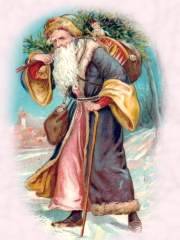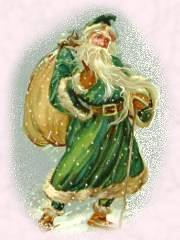The Santa Coke Deal
Im posting this in responce to my MANY santa hats.. that yes are all different colors
Deep Red velvet (not coke red) / White fur
Green velvet / White fur
Black velvet / Black fur
Purple velvet / White fur
Blue velvet with silver snowflakes / White fur
Deep Red Fur / Natural White fur
Az
Older Pictures of Father Christmas



The Santa Coke Deal
By Seeta Pena Gangadharan, AlterNet. Posted January 1, 2000.
http://www.alternet.org/story/2478/
Santa is all about a Coke deal. No joke. Fat and jolly Santa with the red suit and cap, thick black belt and sooty boots, rosy cheeks, luminous eyes and brighter-than-white teeth... is the genius of an advertising campaign by Coca-Cola back in the 1930's.
Now, dear reader, before you go off in a huff and censor this article from Santa-believers, please keep in mind: it ain't no secret that the most revered Claus is corporate sponsored. Coca-Cola remains open and proud of their role in popularizing Santa. They've sponsored gallery exhibitions on "Advertising As Art" that explain this phenomenon -- the most famous being one held at the Carrousel du Louvre (a.k.a., Louvre Gallery in Paris) in 1996. I'm not guilty of spoiling anyone's imagination for passing on this interesting piece of consumer history. This is a real life tale of Santa that deserves to be heard.
Back in the late nineteenth century, when Coca-Cola first started, the whole purpose of the beverage was medicinal. If you were feeling "low" or if you suffered from headaches, a Coke was the perfect remedy. The featured ingredient of cocaine, or coca bean extract, guaranteed a renewed self with greater agility and acuity.
Many folks in quest of this medicinal beverage knew of Coke from the pharmacist. In fact, Coca-Cola paid pharmacists a commission for the sale of this medicinal beverage if drug stores allowed Coca-Cola to install a carbonation tap on the premises.
By the 1930's, Coca-Cola needed to re-evaluate its business outlook and consider how it was going to keep things going in a Depression Era. The more controversial aspects of the beverage had long been dealt with (as early as 1903, coca extract was removed and caffeine took its place). Beverage sales were slowing down -- especially, in the wintery months, and Coca-Cola needed a new hook and sinker to attract the American market.
So, in 1931, Coca-Cola changed its target audience from the adult who lacked pep to the whole family who required cheer and joy. Coca-Cola was a great taste to be enjoyed by everyone! And with that, they decided to launch an extensive advertising campaign to demonstrate its new appeal. Pioneering the use of well-known artists to design their ad campaigns, the company blitzed pharmacies and stores with promotional material that was suitable for the whole family. The illustrations by one artist in particular, the Swedish Haddon Sundblom, landed Coca-Cola the most success, and it is his image of a portly White man in a red suit bringing joy to family and friends simply with a bottle of Coke that we see in shopping malls, greeting cards, commercials, Salvation Army booths, and so on.
Naturally, Coca-Cola cannot be fully credited for bringing Santa into the homes and hearts of Americans everywhere. The history of Santa Claus, the mystery gift-giver, goes back well before the time of the Coca-Cola company -- but in this previous life, Santa wears no red suit. St. Nicholas, loosely based on the fourth-century bishop of Asia Minor; a Scandanavian dwarf or a goat; the white-robed girl, Kolyada, of pre-revolutionary Russia who arrived atop a sleigh with accompanying carollers; and the many religious gift-bearers associated with the Magi explain the cultural roots of Santa Claus. In each one of these Old World depictions of Santa, the costume bears no stain of red... especially, in the case of the Scandanavian version.
In the United States, the Dutch were primarily responsible for spreading the idea of Sante Klaas, based on one of their revered bishops. Sante Klaas gave form to the current myth of Santa and fleshed out his reputation as a gift-giver: eight flying reindeers, living near the North Pole, filling socks with presents, arriving through the chimney. However, the visual image was not honed until much later, with Coca-Cola.
In 1822, an American professor, Dr. Clement Clarke Moore, wrote "The Visit of St Nicholas," which is known today as the "The Night Before Christmas." His description of Santa is suggestive of a fat man, but in the gnomish fashion of the earlier European versions.
The poem reads: "His eyes how they twinkled! His dimples how merry! His cheeks were like roses, his nose like a cherry; His droll little mouth was drawn up like a bow, And the beard on his chin was as white as the snow... He had a broad face, a little round belly, That shook when he laughed, like a bowl of jelly. He was chubby and plump, a right jolly elf... "
Nearly forty years later, political cartoonist Thomas Nast drew a version of St. Nicholas for Harper's Illustrated Weekly. He wears a woolly-furry suit and resembles a stout, bearded elf with whiskers and a beard. The quote, unquote trademark look is not apparent. Nast often created etchings in black and white that presage the Coke Santa (belted suit). However, in Nast's color renditions, Santa vaguely echoes the modern, commercial image. Most notably, the bright red color is missing.
Why, dear reader, is this so? Well... here's where the genius of Coca-Cola comes in. A couple of explanations are due. First, Haddon Sundblom's image of Santa Claus hit the right buttons in terms of stirring the hearts and quenching the thirst of consumers everywhere. Modelled on a retired salesman named Lou Prentice, Sundblom's Santa had just the right combination of happy wrinkles, prompting Coca-Cola to hire Sundblom to continue making Coke ads with this model for the next 35 years. He was a comforting face that well-suited an enjoyable beverage.
Second, compared to the limited audience of Harper's Illustrated Weekly, Coca-Cola aimed to saturate as many outlets as possible. They orchestrated a full-frontal attack on the market with Santa-Coke propaganda. Magazine advertisements were particularly effective, considering that during that era, print publications were like tv: able to communicate over and over and over again the same image and slogan to a mass audience. Point-of-purchase promotional items were extremely common. Collectibles, too, were another way that Coca-Cola could expand its presence -- a strategy that is standard today for any advertiser, from Nike to Joe Camel.
Finally, Coca-Cola patented a formula for red -- that bright red used for Coke packaging and for Santa's suit. Any of the artists hired to work for Coca-Cola were required to use this color red, influencing consumers, no doubt, to make the constant association between red and Coke... and well, Santa. This is perhaps the biggest kicker, considering Nast's version, Moore's literary image, or early European portrayals show little consistency in this regard.
***
These days, the sacredness of the Coke's Santa has expired itself. Santa is ubiquitous, Coke is ubiquitous, but no one really remembers that the two were at one time, closely entwined. It's a history that is mostly understood by PR advisers and college marketing students, and maybe the slew of French and tourists who saw the "Advertising as Art" exhibit at the Louvre. Occasionally, Coca-Cola revive Sundblom's Santa in a commemorative appeal to its loyal consumers, but the story is rarely told.
As Mark Pendergrast, author of For God, Country and Coca-Cola, concluded: "Prior to the Sundblom illustrations, the Christmas saint had been variously illustrated wearing blue, yellow, green, or red.... After the soft drink ads, Santa would forever more be a huge, fat, relentlessly happy man with broad belt and black hip boots-and he would wear Coca-Cola red .... While Coca-Cola has had a subtle, pervasive influence on our culture, it has directly shaped the way we think of Santa."


0 Comments:
Post a Comment
<< Home